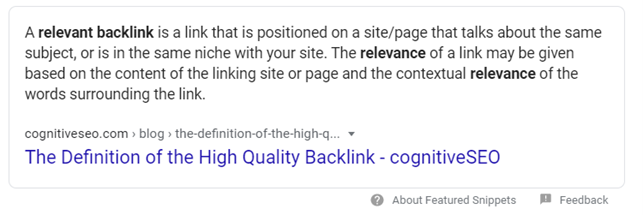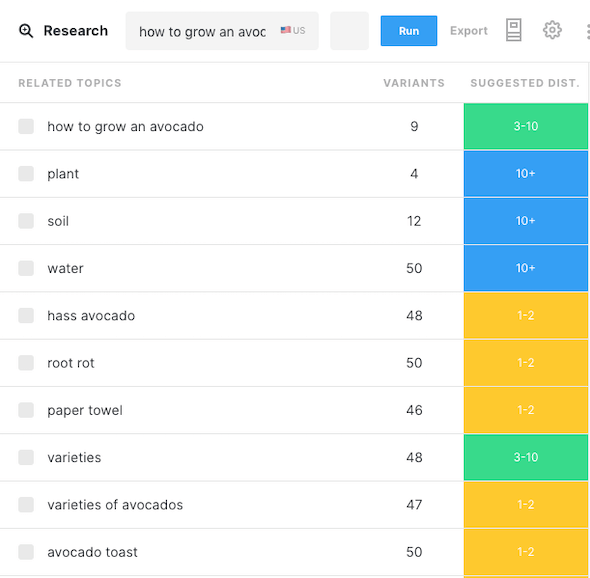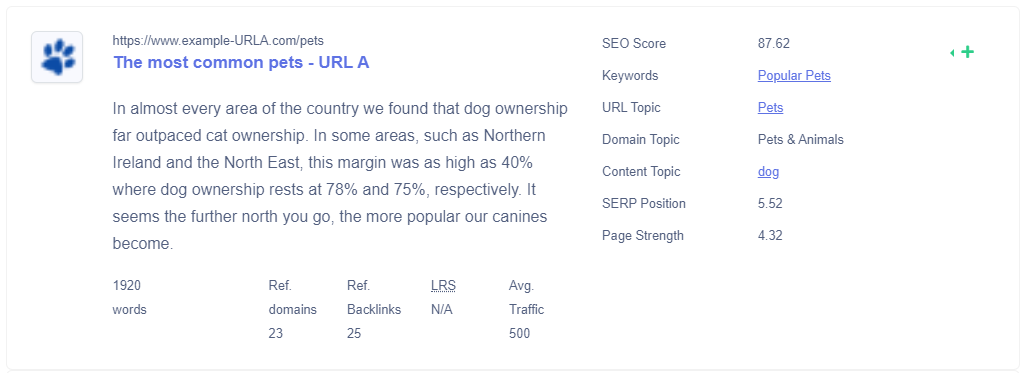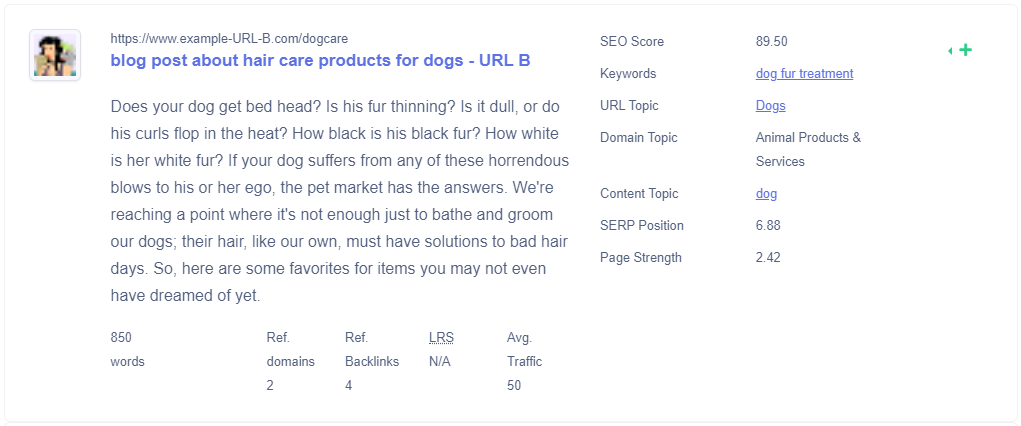There has been a consensus for many years in the SEO industry that the authority matrices are the best way to figure out a website’s strength (i.e. it’s chance of ranking high in the search results). Here, there have been three major SEO companies in particular that have dominated the market, each with their excellent way of calculating this authority. I am thinking of MOZ and their Domain Authority, ahrefs, and their Domain Rating as well as Majestic and their Trust flow metrics.
I do not really want to criticize them, because for many years they have made it easier for us marketers to navigate in the world of SEO, which in itself is a marketing discipline that requires you to have an overview of many things at once.
However, what I want to advocate in this post is whether these aging ways of looking at SEO actually provide the same value today and whether we in the industry should be more aware of a new type of metric, Relevance?
Take a shortcut and jump straight to the findings and conclusions
- The start of relevance in SEO
- This is how Google might determine relevance
- The old way of looking at backlinks
- The new way of looking at backlinks
- On-page relevancy metrics you can use
- Off-page relevance metrics you can use
- Best metrics to assess relevancy in backlinks and how it works
The old PageRank methodology
It goes without saying that if you own a blog or other form of digital media where you want to give your users as much relevant and valuable content as possible, then you have to make sure that you only write in an interest to serve your users, right?
But why have we for so many years been preoccupied with, the score of our website authority metric?
The answer may lie in the way Google in its earlier days viewed a website and its trustworthiness. Google used, among other things, a formula that formed the basis of the number of backlinks, as a voice for one’s credibility. A bit like a scientific article and its citations from other articles. The formula is today known as PageRank and has also been portrayed by Google itself, so you as a website owner could view your own PageRank.
However, this era has passed, and Google has closed accessing PageRank.
So, the only way we marketers could get information about our site’s authority metric was to use tools like MOZ, ahrefs, and Majestic.
This way of looking at a website, many clues suggest that Google does not value as high anymore, or in that case, it does not have nearly the same weighting as once.
It also makes good sense, because it’s a lot easier to manipulate Google if it’s about the number/authority of backlinks, rather than if it’s about the relevance of backlinks. Because then you can just buy yourself a bunch of backlinks, without the need to spend time or resources on ensuring that they have relevance or provide any real value for your users.
The entry of relevance in SEO
Fortunately, there are many other than us who have noticed that Google focuses more on relevance, rather than static authority metrics. It may also be unavoidable if you follow Google’s latest major algorithm updates, where AI and text comprehension have also been in focus in many of them.
The first real big relevancy-oriented update from Google was Panda. Panda’s purpose was to make sure that Google could sort low-quality content pages from the top positions in Google.
Subsequently came RankBrain, which really kick-started the AI/machine learning approach to Google Search. Before, Google would only look at and match the words from the search query with those on the page, to now understand the meaning of the word and the context of your page and then show the most relevant results to the query.
The latest major algorithm update is BERT.
BERT’s role is then to ensure finding the right answers to the many questions that are searched in Google.
And we may look forward to a possible new core update in the future, which could go under the name BigBird, which deals with text processing of large amounts of text.
One of the reasons Google would like to implement such an update may be because the machine may have had difficulty determining the overall topics for longer texts and thus longer texts will actually be diluted and the parent topic will be mixed with sub-topics.
So Google has gone from being a machine that could only match the user’s search query with keywords on the pages, from sites with many backlinks (ie authoritative pages that were often on page 1) to now to a much greater extent understand the content of the page and thus answering the user’s search query without the need to take simple keywords into consideration.
How Google Assess Relevance
As marketers, of course, we want to become wiser about how Google addresses relevancy so we can make sure we produce content and do SEO that complies with Google’s new ways of viewing web pages and especially backlinks.
A Google patent from 2010 gives a hint as to how Google might view links. according to the patent, it raises the possibility that not all links on a page are equally important or are weighted equally.
Here it is argued that links that have a prominent position may have a higher weighting than links that are placed lower on the page or worse in the form of ads.
In addition, links from topic-relevant sources are weighted higher than from irrelevant sources. Both from the page that receives the link and the page that links.
To better understand what a relevant backlink looks like, we ask the world’s most knowledgeable machine, namely Google Search:

So a relevant backlink is a link from a website that has some content that is relevant to your page. But what does that really mean?
Unfortunately, Google does not provide a better answer as to what a relevant link is, but at least they say what to avoid with links.
So is it impossible for us to know what Google thinks is relevant?
Not necessarily. There are others who have had the same question and they have come to the following conclusions:
The linking text (anchor text) has an impact on the relevance (source).
The linking page and your page should be about the same topic (source).
The text of the linking page should make contextual sense. (source)
According to the featured snippets from before, the surrounding text also has a weighting.
Of course, these are not confirmed by Google in any way (they never confirm ranking factors), which means they have to be taken with a grain of salt. However, they make very good sense and can be used as indicators of relevance.
However, they are not very manageable and almost impossible to scale in relation to link building.
What are the aging SEO metrics?
Before we delve into this section, it’s good to understand that just because these metrics its aging does not mean that they do not matter to rankings or the way we work with SEO.
But before we can talk about the new, we must also talk about the old.
Everyone who has worked with SEO is guaranteed to know PageRank and those who have worked with link building must also know about authority metrics, such as Domain authority, trust flow, URL Rating, etc.
They have stood their ground and to a large extent they still stand, but with the way Google has managed to bring NLP into their search algorithms, the importance of these metrics will also become less significant. Maybe one day they will not have any significance at all? (I personally do not think so myself, as Google probably needs a voting system, to understand the most popular sites).
The metrics that we would like to highlight in this section are metrics that are based on static factors and that give a score based on a linear or logarithmic scale.
We have mentioned them above, but we will dig a little deeper into them, to understand how they work.
Let’s start with authority metrics calculated based on the entire domain.
First and foremost, an authority’s metric is a metric that assesses how high a website’s popularity is, on the idea that a link is a vote from another website.
The most famous is probably Google’s own RankPage, which with this crazy formula shows how it can be done:

But after Google chose to remove the access to the RankPage toolbar, companies began to appear with the mission to emulate the Google RankPage algorithm.
Most of them you with guarantee have heard about.
- Domain authority from MOZ.
- Domain Rating from Ahrefs.
- Domain Authority Score from SEMrush.
- Trust Flow from Majestic.
They are all developed differently and their score basis is calculated on vastly different database sizes, which therefore also affects their accuracy.
A completely different thing, in this case, is that the authority metrics that are invented by these companies are metrics that are something Google uses to determine rankings.

Therefore, I can not stress enough that these metrics are not the truth and in principle do not tell anything about the change to rank higher in Google. However, they can be used to the advantage as indications of a website’s popularity in terms of backlinks.
Relevance. The new SEO metrics you need to know
Google and the best SEO experts in the world all advocate for relevance as being the mainstay of link building.
The biggest challenge with relevance is that it is difficult to scale with. In addition, the current SEO giants, as mentioned before, have not been good enough to quantify relevance so that marketers can use relevance in the same way as with authority. This is also the biggest problem that our surveys have shown, in terms of relevance.
From a survey we conducted on link building, with 336 respondents including SEO employees in small and large companies, 92% of all respondents answered that they had difficulty scaling their link building with relevance. In addition, 86% thought that relevance often became too vague to work with.
In in-depth interviews, we found that this is because they find relevance in link build and in SEO in general too “fluffy”. This is due to the lack of relevance metrics which will make it manageable for them to work with relevance.
But aren’t there any SEO metrics that make relevance quantitative and manageable at all? – Yes, it there is, and we will dive into them now.
Relevance in on-page SEO
Fortunately, there are many new and emerging companies that are trying to solve the challenges that many marketers have with designing relevant content that benefits their users.
However, not everyone has SEO in mind, by quantifying relevance to a score. MarketMuse has seen this and they have created a great tool for finding semantically relevant keywords for your content.
They manage to pull a list out of each of the search queries you want to rank for, then display the keywords with the highest relevancy score for your page’s content.

In the example above they show semantically relevant keywords for the search query “how to grow avocados”.
Relevance metrics in link building
Okay, we have now told that there are actually some who are trying to make it easier for us marketers to create relevant content, but what about link building and backlinks?
There has been an attempt from one of the aforementioned SEO companies, namely Majestic. They had in 2014 built what they call Topical Trust Flow and is a metric that is based on general topics of domains and web pages.
The problem with Topical Trust Flow is that it only addresses the overall topic and we who have worked with SEO and content for many years, know that content on webpages is rarely just about one thing and that there is a difference in how much the individual topics “weigh” in relation to the whole meaning of the text.
Therefore, Topical Trust Flow quickly becomes very superficial and cannot be used to assess the degree of relevance between two web pages.
So are there others who have managed to create a manageable metric that can measure the relevance between two pages?
Yes, there is, and you do not have to go very far to experience it.
The world’s first relevance metric for backlinks
Tabtimize has created a relevancy metric that manages to quantify a very comprehensive and complex text and context analysis into a manageable score.
It is called Link Relevance Score and can be used to assess and scale contextually relevant link building.
The way it works is that an analysis is made of the page’s content. The analysis goes through 7 levels of text and context analysis stages, this is done to understand not only the context of the selected page but also the context that the page has in relation to its entire domain. In addition, it goes in-depth with the page’s individual sections, possible anchor texts, and their impact on the understanding of the backlink, the page’s main topics, and semantic context.
Dive into the magic behind the Link Relevance Score
There are two ways in which the Link Relevance Score (LRS) is calculated.
1. Pages that do NOT already have a link between each other. This method is used to assess the relevance between two link opportunities.
2. Pages that already have a link between each other. This method is used to assess the relevance between two linking pages.
For example, if you want to find out what the relevance is between your page and a link prospect, then the AI will analyze both pages separately, to then be compared and assigned a Link Relevance Score.
The difference lies in how the algorithm understands and weights the anchor text.
With pages that already link, the anchor text is a very important indicator to show what the link is about, both for the users and the machines. For linking pages, the anchor text has already been determined, which means that the final LRS has been calculated.
For pages that do not already link, the LRS will be calculated for possible anchor text that the text analysis has found relevant for the two pages and the option with the highest LRS will be displayed.
To make it even more complicated (hold on tight), there is a difference in the LRS depending on which of the two pages receives the link.
Therefore, there will also be a difference between whether it is your page that receives the link, or whether it is the other pages that received the link.
Explanation of why there is a difference in LRS according to who receives the link:
Let’s say you have a page where you write about different types of pets. We call your page “URL A”. Here you write sections about the most common pets, dogs, cats, rabbits, goldfish, etc.

The other page that is relevant to yours is a website that sells animal care products. We call this page “URL B”.
They have a blog post about fur care products for dogs. They only mention dogs.

Both pages are in theory relevant to each other. But because URL B is more specific, it will make sense for URL A to link to URL B. But this is only the case if the anchor text suggestions are about any kind of care products for dogs.

If the anchor text is more about dogs as pets and dogs in general, then it will make more sense for URL B to link to URL A. Hence that URL A goes more in-depth with dogs in general.

This will also be reflected in the LRS that will be given between the two pages which are displayed in the Link Relevance Scheme below:

Final words
Relevance has been a term that has been virtually absent in the SEO industry for many years, but as Google expands their understanding of text and the context of search queries, it also calls for higher awareness of relevance from us marketers.
Many of the giants of the current SEO tools have not been good enough to keep up with the changes that relevance will bring, which also provides fertile ground for new emerging companies who understand the change that the SEO industry is facing and develop tools that solve the challenges, which we marketers are going to face.
When it comes to relevance and backlinks, Tabtimize in particular has taken the lead and really made a tool that benefits all marketers who do link building. There is no longer a need for countless hours spent on researching relevant link opportunities and marketers can now start working with scaling in their efforts with relevance in link building. All this thanks to the Link Relevance Score.



